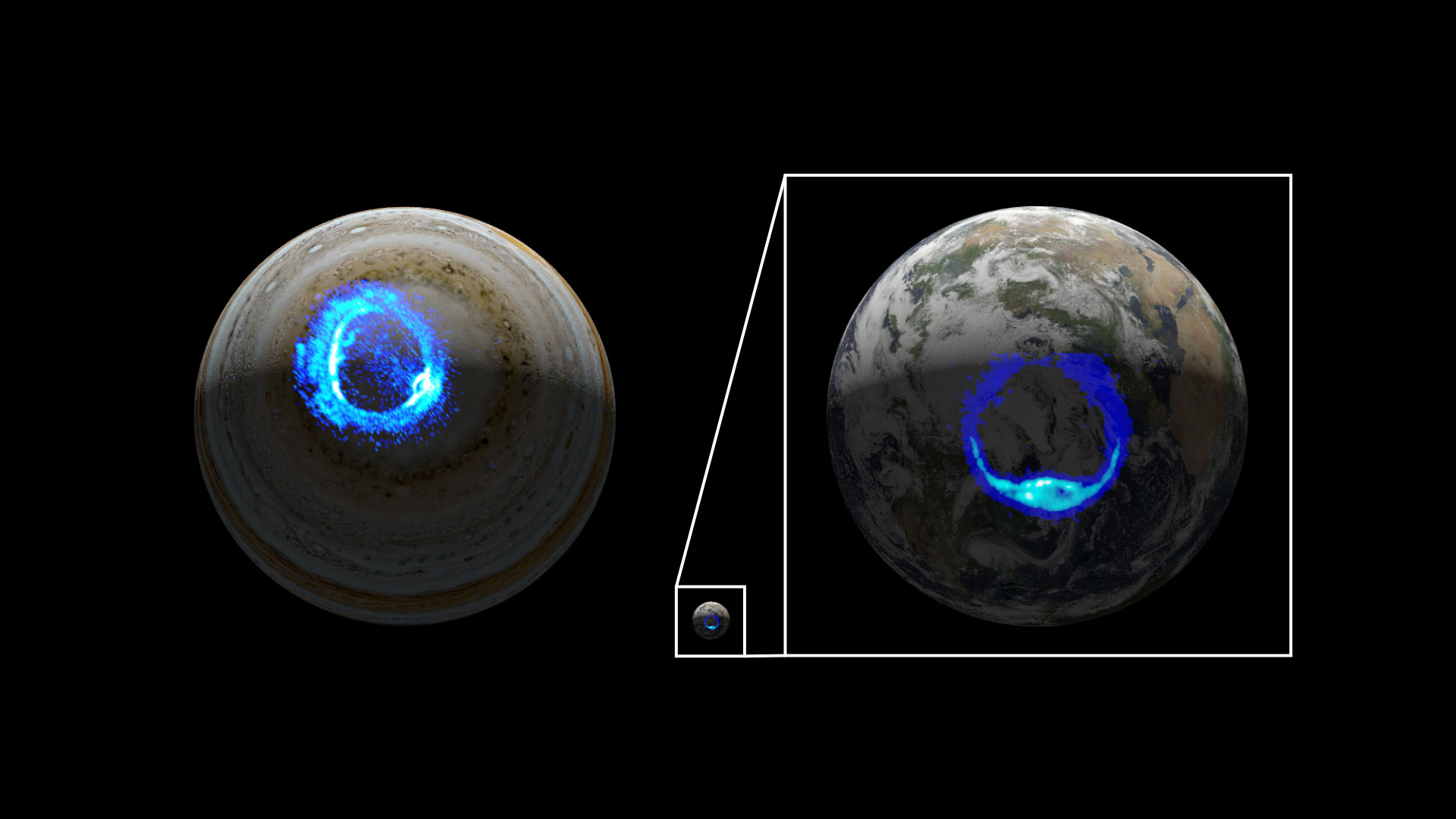Glowing 'dawn storm' auroras that blaze in Jupiter's morning skies are born in darkness
New images revealed the full cycle of these intense polar light displays.

Jupiter’s otherworldly glimmer of polar auroras is periodically brightened by brief but intense early morning displays known as dawn storms. Now, for the first time, scientists have figured out where dawn storms come from, how they grow, and that they're even more powerful than expected.
Scientists knew about dawn storms from telescopes in space and on Earth. But most of those instruments only provided partial glimpses of the storms, showing whatever was visible on the side of Jupiter that faced the sun.
Enter the Juno mission. The Ultraviolet Spectrograph on NASA's Juno spacecraft filled in the gaps by capturing this glowing phenomenon from overhead for eight hours at a stretch, "from its initiation to its end and from the nightside of the aurora onto the dayside," which had never been done before, according to a new study.
Related: Aurora photos: Northern Lights dazzle in night-sky images
Juno revealed that the dawn storms form as isolated glowing spots in auroras on the planet's night side. As Jupiter rotates, the storms travel to the daytime side and glow even brighter, spewing up to thousands of gigawatts of ultraviolet light into space. At their brightest, dawn storms produce at least 10 times more energy than Jupiter's typical auroras do, the scientists wrote.
"The energy in these dawn aurorae is yet another example of how powerful this giant planet really is," study co-author Scott Bolton, principal investigator of Juno from the Southwest Research Institute in San Antonio, Texas, said in a statement.
"More energetic than usual"
Jupiter's auroras are among the most powerful in our solar system, and they appear when high-energy electrons stream across the gas giant's magnetosphere and pour into the upper atmosphere to excite and illuminate atmospheric gases, according to NASA. This forms glowing rings that are visible at the planet's north and south poles.
Breaking space news, the latest updates on rocket launches, skywatching events and more!
Observations from the Hubble Space Telescope had already revealed recurring instances of brightening in the dawn side of Jupiter's polar auroras that seemed to last one to two hours, caused by particles — mostly electrons — that were "more energetic than usual," said lead study author Bertrand Bonfond, a research associate at the Université de Liège Space sciences, Technologies, and Astrophysics Research (STAR) in Belgium.
Related: Northern Lights: 8 dazzling facts about auroras
"Some of these dawn storms, including one that was observed by Hubble as Juno was approaching Jupiter before its orbit insertion in 2016, register as the brightest auroras we have ever seen on Jupiter," Bonfond told Live Science in an email.
"However, we weren't sure whether they actually formed at dawn and remained there, or whether they initiated in the night side and then rotated towards dawn," Bonford said. Because Hubble observations were limited to just 40 minutes at a time, "we also weren't sure how they evolved afterwards," he added. "And while we were convinced that such dramatic auroras should correspond to some dramatic events in the magnetosphere, we were not really sure which ones."
"A brand new picture"
With polar aurora data gathered by Juno during 20 orbits, the scientists assembled "a brand new picture of dawn storms," according to the study. They found that the birth of a dawn storm began before midnight and then brightened over the next few hours, intensifying as Jupiter rotated toward the sun. A few hours after forming, the first bright zone divided "with a branch moving poleward," the scientists wrote. Space between the split arcs filled with brightness as the arcs grew, and then finally, the entire feature dimmed. Beginning to end, the storm lasted between 5 and 10 hours, the study authors wrote.
The scientists were also surprised to find that Jupiter's dawn storm auroras shared features in common with a type of Earth aurora called substorms, which display sudden and intense brightening triggered by a "short-circuit" of plasma flows. This similarity initially puzzled the scientists, as the aurora-shaping magnetospheres of Earth and Jupiter are different in many ways, such as in their size, composition and distance from the sun, Bonford said in the email.
"Based on our study, we now think that both the substorms at Earth and the dawn storms at Jupiter arise from the crumbling of the magnetosphere after they accumulated too much mass and energy in the magnetotail," which is the side of the magnetosphere opposite the sun, Bonford explained.
However, this accumulation of energy and mass happens for different reasons in the magnetospheres of the two planets. For Earth, the excited particles come from solar winds, while for Jupiter, extra ionized material is spewed into space by the volcanic moon Io. But despite having different origins, the results — dawn storms on Jupiter and substorms on Earth — are unusually similar.
"Different causes lead to the same consequence," Bonford said. "That wasn't expected at all."
The findings were published online March 16 in the journal AGU Advances.
Originally published on Live Science.



